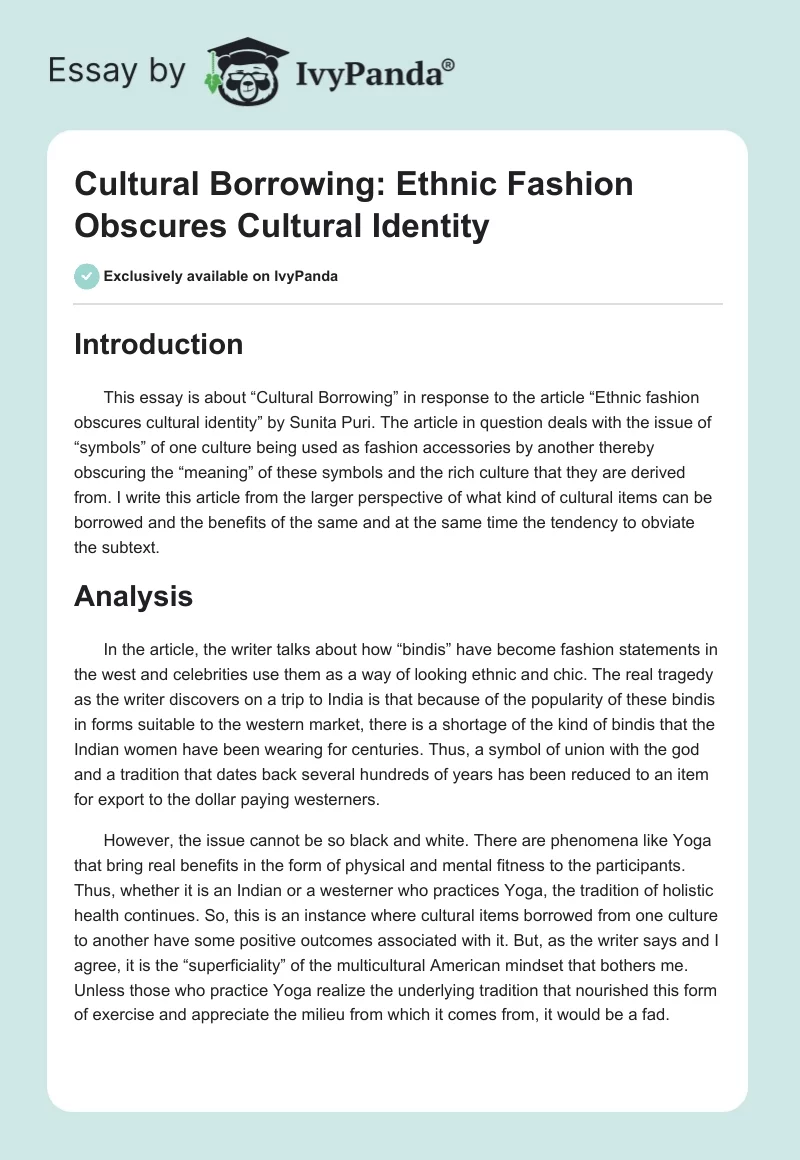Introduction
This essay is about “Cultural Borrowing” in response to the article “Ethnic fashion obscures cultural identity” by Sunita Puri. The article in question deals with the issue of “symbols” of one culture being used as fashion accessories by another thereby obscuring the “meaning” of these symbols and the rich culture that they are derived from. I write this article from the larger perspective of what kind of cultural items can be borrowed and the benefits of the same and at the same time the tendency to obviate the subtext.
Analysis
In the article, the writer talks about how “bindis” have become fashion statements in the west and celebrities use them as a way of looking ethnic and chic. The real tragedy as the writer discovers on a trip to India is that because of the popularity of these bindis in forms suitable to the western market, there is a shortage of the kind of bindis that the Indian women have been wearing for centuries. Thus, a symbol of union with the god and a tradition that dates back several hundreds of years has been reduced to an item for export to the dollar paying westerners.
However, the issue cannot be so black and white. There are phenomena like Yoga that bring real benefits in the form of physical and mental fitness to the participants. Thus, whether it is an Indian or a westerner who practices Yoga, the tradition of holistic health continues. So, this is an instance where cultural items borrowed from one culture to another have some positive outcomes associated with it. But, as the writer says and I agree, it is the “superficiality” of the multicultural American mindset that bothers me. Unless those who practice Yoga realize the underlying tradition that nourished this form of exercise and appreciate the milieu from which it comes from, it would be a fad.
And as with all fads, once the initial euphoria dies down, they pass away into meaninglessness and obscurity. We, as individuals seek identity and security from the world at large and we should strive to move beyond the surface and look for meaning. This is particularly true for people of our age who face a profound crisis of meaning in our personal lives due to the “byte” driven infotainment and resultant short attention spans that we have.
The point here is I as an Asian American would want to retain symbols of my identity with me. The same goes for my American friends. The tragedy occurs when in “melting pots” like the US, we swap cultural items with each other only to “belong” and not necessarily to appreciate the rich traditions of both. If Italian Americans are identified with pasta and not the renaissance and Chinese Americans are recalled for acupuncture but not for their Confucian scheme of thought, there is every danger that we lose our status as the “immigrant’s dream”.
My experience has taught me that I want to move beyond the hyphenated experience (much like the writer) and want to be part of the milieu in which I am currently in as well as from where I originally came from. Thus, it is a difficult balancing act, but, one that I can do if there is more understanding of the complexities of cultures is prevalent.
Conclusion
In conclusion, it is apparent that the article in question is more about the writer’s plea for being recognized for her country’s culture rather than as a fashion accessory. I take the point that not all cultural items that are borrowed are bad. They help the intermingling of cultures and assimilation of people from different cultures.


